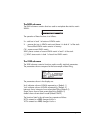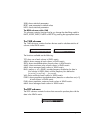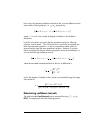
Page 18-23
Θ Point estimation: when a single value of the parameter θ is provided.
Θ Confidence interval: a numerical interval that contains the parameter θ at a
given level of probability.
Θ Estimator: rule or method of estimation of the parameter θ.
Θ Estimate: value that the estimator yields in a particular application.
Example 1
-- Let X represent the time (hours) required by a specific
manufacturing process to be completed. Given the following sample of values
of X: 2.2 2.5 2.1 2.3 2.2. The population from where this sample is
taken is the collection of all possible values of the process time, therefore, it is
an infinite population. Suppose that the population parameter we are trying to
estimate is its mean value, μ. We will use as an estimator the mean value of
the sample, ⎯X, defined by (a rule):
For the sample under consideration, the estimate of μ is the sample statistic ⎯x =
(2.2+2.5+2.1+2.3+2.2)/5 = 2.26. This single value of ⎯X, namely ⎯x = 2.26,
constitutes a point estimation of the population parameter μ.
Estimation of Confidence Intervals
The next level of inference from point estimation is interval estimation, i.e.,
instead of obtaining a single value of an estimator we provide two statistics, a
and b, which define an interval containing the parameter θ with a certain level
of probability. The end points of the interval are known as confidence limits,
and the interval (a,b) is known as the confidence interval.
Definitions
Let (C
l
,C
u
) be a confidence interval containing an unknown parameter θ.
Θ Confidence level or confidence coefficient is the quantity (1-α), where 0 < α
< 1, such that P[C
l
< θ < C
u
] = 1 - α, where P[ ] represents a probability
(see Chapter 17). The previous expression defines the so-called two-sided
confidence limits.
Θ A lower one-sided confidence interval is defined by Pr[C
l
< θ] = 1 - α.
Θ An upper one-sided confidence interval is defined by Pr[θ < C
u
] = 1 - α.
∑
=
⋅=
n
i
i
X
n
X
1
.
1


















